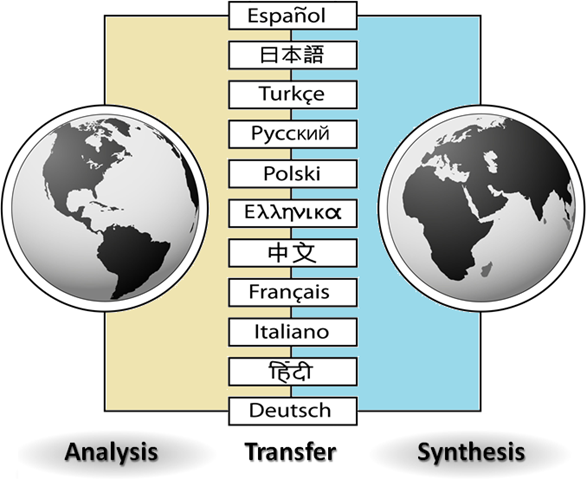14 Apr Translation: Inverted Communication
 Lately I’ve been concentrating on modeling communicative skills. Whether speaking, signing, gesturing or writing, we begin with intent and wrap symbols around the intent or message to encode it. Translating and encrypting start with a fully encoded message, and unwrap it, before rewrapping it in a different form that is intended to preserve the original intent. Translation is an application of communicative skills.
Lately I’ve been concentrating on modeling communicative skills. Whether speaking, signing, gesturing or writing, we begin with intent and wrap symbols around the intent or message to encode it. Translating and encrypting start with a fully encoded message, and unwrap it, before rewrapping it in a different form that is intended to preserve the original intent. Translation is an application of communicative skills.
One way to find out if you have successfully taught a computer to understand language is to ask it to translate input in one language into output in another. Just as the Turing test asks you to try to decide if the output came from man or machine, in this test we compare a human translation of the same text. If the machine did a comparable job, accurately capturing the intent of the original, using acceptable diction and grammar in the target language, then the machine passes the test of linguistic competence. Linguistic competence is a key goal, though the final test is in developing a single program that can translate from one source language (SL) to many target languages (TLs) with accuracy.
| Understanding Context Cross-Reference |
|---|
| Click on these Links to other posts and glossary/bibliography references |
|
|
|
| Prior Post | Next Post |
| Making a Pattern of Comprehension | From Concept to Communication |
| Definitions | References |
| translating natural language | Nirenburg 1987 |
| computer modeling | Allen 1987 |
| understanding intent | Winograd 1983 |
The cognitive model for translation from one language to another has an inverse symmetry to the communication model. It is shown by concatenating two communications with the comprehension pattern introduced in the previous post and eliminating production from the first and comprehension from the second. Translation presumes the existence of an articulate expression and does not include the comprehension of the message after translation. In order to achieve the goal of translation (accurate communication of a message), the source language message must first be understood, then reproduced in the target language so it retains the original meaning.
Translation as a communicative process involves the reverse symmetry of dialogue. The symmetrical model shown in the illustration is useful for computer-aided or machine translation.
Sergei Nirenburg defines machine translation this way: “The computer must be able to obtain as input a text in one language (SL) and produce as output a text in another language (TL)…” (1987). Production follows comprehension. In other words, synthesis follows analysis. The translation model is depicted in the illustration at right.
Stages of Translation
It has been postulated that MT involves three stages: analysis, transfer, and synthesis: inverted communication. Analysis corresponds to comprehension, synthesis corresponds to production, and a rough correlation between transfer and the concatenation of two communication processes can be inferred. The transfer process has been the subject of much debate, experimentation, and practical application. Some different transfer schemes are mentioned later in this chapter in the sections on history and state of the art.

An alternative method used in some MT systems takes an interlingua approach in lieu of transfer. Both transfer and interlingua fit between analysis and synthesis. So far as the machine is concerned, however, synthesis begins before the transfer occurs. Because the input is a symbolic string with no self-evident meaning, the machine must actually synthesize the symbolic core, or message, by analyzing the input against the rules and/or patterns in the knowledge base. It is apparent, therefore, that synthesis (or re-creation of the message in a different language) is the objective of analysis in translation.
A deep examination of the target language sentence synthesis process will show that analysis of the semantic core is the basis of sentence synthesis; thus, the clear demarcation between analysis and synthesis begins to blur. Nonetheless, the overall division of processing the source language text and the target language text can be accurately designated as analysis and synthesis stages. Our process model will leverage this knowledge of sequence to automate these functions in software.
| Click below to look in each Understanding Context section |
|---|









